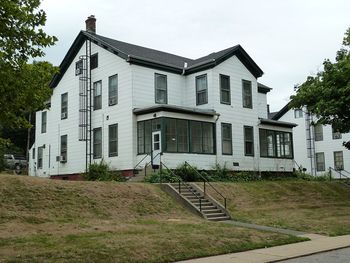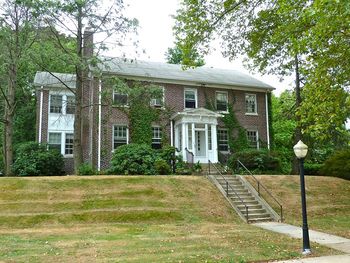Fort Wadsworth (1)
|
Fort Wadsworth (1) (1865-1994) - A New York Coastal Fort first established as Fort Richmond before the War of 1812 on Staten Island, Richmond County, New York. Renamed 7 Nov 1865 after Bvt. Brigadier General James Wadsworth who was killed in May of 1864 at the Battle of the Wilderness during the U.S. Civil War. Deactivated in 1994.
HistoryPart of the Harbor Defense of Southern New York. Established in 1865 by renaming Fort Richmond. The Fort was later expanded during the Endicott Period with the addition of several coastal batteries. A 1902 consolidation brought all Staten Island military fortifications, including Fort Tompkins (1), into Fort Wadsworth. War of 1812 (1812-1814) In 1808 there were four forts guarding the narrows on Staten Island, Fort Tompkins (1) at the top of the hill, Fort Morton (1) and Fort Hudson (2) on the slopes, and Fort Richmond at water level. None of these forts were considered complete or adequate. In May 1814 Fort Tompkins (1) and Fort Richmond were completed using red sandstone construction. At the end of the war, in December 1814, the combined fortifications boasted some 900 artillery pieces. After the war, the forts on Staten Island fell into disuse and by 1835 they were declared "unfit for use". In 1836 the U.S. Government-authorized purchase of 47.5 acres including the forts but did not complete the transaction until 1847. When the land purchase was completed the red sandstone forts were torn down and Fort Richmond/Battery Weed and Fort Tompkins (1) were rebuilt in their current form. They were completed in August 1861, just after the start of the U.S. Civil War. By this time Fort Hudson (2) had become Battery Hudson and Fort Morton (1) had become Battery Morton.
U.S. Civil War (1861-1865)Both Fort Richmond and Fort Tompkins (1) expanded during the U.S. Civil War and the troop population peaked in 1864 at over 1900 troops. On 7 Nov 1865 Fort Richmond was designated Fort Wadsworth by War Department General Order #161. Post U.S. Civil WarThe U.S. Civil War brought the realization that all Third System Forts were obsolete because rifled naval guns could destroy them without ever coming into range of their smoothbore weapons. This fundamental shift in technology stalled the construction of new coastal forts and eventually brought it to a halt in the mid-1870s when congress refused to fund any construction. Fort Wadsworth was no exception to this and the armament in place gradually deteriorated until 1890 when not a single one of Fort Wadsworth's batteries was complete, in good condition, and fully armed. From a wartime peak of 1900 men the garrison had been reduced to 41 men by 1884. Endicott Period (1890-1910) The Endicott Board on coastal defenses in 1886 recommended a sweeping upgrade to coastal defenses that had the New York Harbor defenses as the top priority. It took a while for the Endicott Board's recommendations to translate into the new weapons and battery designs needed but by 1895 work had started at Fort Wadsworth. Between 1895 and 1904 six new Endicott Period batteries were built and several of the existing batteries were upgrade to Endicott Period standards and many of them were renamed in the process. Fort Wadsworth expanded to 226.5 acres between 1892 and 1901 with the acquisition of private land to support the new dispersed gun batteries. At the conclusion of the land acquisition War Department General Order # 16 on 14 Feb 1902 applied the name Fort Wadsworth to all the fortifications on the military reservation on the west side of the Narrows. In this same order the fort at the water's edge (Fort Richmond then Fort Wadsworth) was designated as Battery Weed. In the years after the Spanish-American War up to the beginning of World War I in Europe in 1914 the garrison usually numbered between 400 and 500 men. By 1916 the garrison was up to 1600 men which were enough to man all the guns and it stayed at that level until the war was over in 1918.
World War I (1917-1918)Unlike some coastal forts, Fort Wadsworth did not lose many of its guns to the conflict in Europe and there seemed to be an increased sense of urgency in 1917 when certain batteries were directed to be ready to fire day or night. As the war drew to an end in 1918 the alert status was relaxed. The war ended in 1918 and demobilization began quickly. In 1919 Fort Wadsworth became an infantry post and only a very small caretaker contingent of Coastal Artillery personnel remained.

In 1928 there was only a small Coastal Artillery detachment of 12 enlisted men and one officer to care for all the armament and all the batteries on Fort Wadsworth. In 1929-1931 modern concrete infantry barracks were constructed. In 1932 eight of the 12" guns were fired for the first time since 1909 during the 4th of July celebration. In 1935 the W.P.A. began construction of several post facilities including the Post Exchange, the Officer's Club, part of the seawall, and several roads. World War II (1941-1945)By February of 1941, all of the Infantry units had left Fort Wadsworth and the Coastal Artillery was in charge of the post. The mission during World War II was Coastal Defense and Anti-Aircraft Defense. During one exercise all active batteries were fired including Battery Catlin, Battery Turnbull, Battery Mills and Battery Dix. Several batteries were built on Fort Wadsworth during World War II along with many anti-aircraft positions.
Cold War (1947-1991)TBF
Current StatusNow a part of Gateway National Recreation Area. No period guns or carriages in place.
See Also: Sources:
Links: Visited: 15 Aug 2010
| |||||||||||||||||||||||||||||||||||||||||||||||||||||||||||||||||||||||||||||||||||||||||||||||||||||||||||||||||||||||||||||||||||||||||||||||||||||||||||||||||||||||||||||||||||||||||||||||||||||||||||||||||||||||||||||||||||||||||||||||||||||||||
- Visited
- All
- New York All
- New York Forts
- Coastal Forts
- Endicott Period Forts
- Third System Forts
- World War I Forts
- World War I Coastal Forts
- World War II Forts
- World War II Coastal Forts
- U.S. Civil War Forts
- New York City Forts
- New York Richmond County
- Harbor Defense of Southern New York
- Fort Wadsworth (1)
- National Park
- 2010 Northern Trip
- Must See


